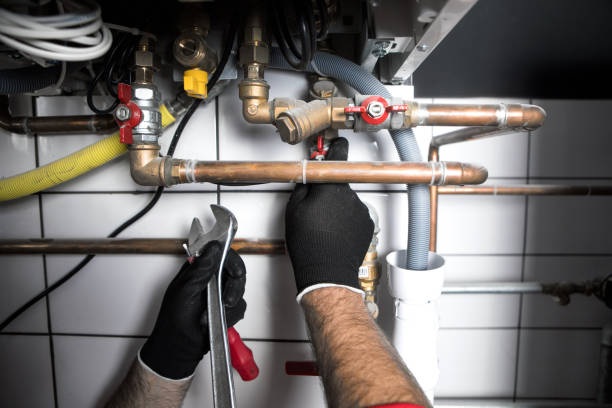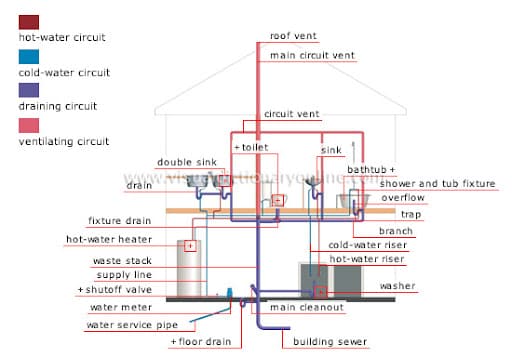Understanding Your Property's Plumbing System Anatomy
Understanding Your Property's Plumbing System Anatomy
Blog Article
How do you actually feel in regards to The Inner Workings of Your Home's Plumbing?

Understanding exactly how your home's pipes system functions is crucial for every property owner. From delivering tidy water for alcohol consumption, cooking, and bathing to securely removing wastewater, a well-maintained pipes system is crucial for your family members's wellness and convenience. In this thorough overview, we'll discover the elaborate network that makes up your home's plumbing and offer ideas on maintenance, upgrades, and dealing with usual concerns.
Intro
Your home's pipes system is more than simply a network of pipes; it's a complex system that ensures you have access to clean water and effective wastewater elimination. Recognizing its components and exactly how they collaborate can aid you protect against costly repair work and guarantee everything runs smoothly.
Basic Components of a Plumbing System
Pipes and Tubing
At the heart of your plumbing system are the pipelines and tubes that carry water throughout your home. These can be constructed from numerous products such as copper, PVC, or PEX, each with its advantages in terms of resilience and cost-effectiveness.
Fixtures: Sinks, Toilets, Showers, and so on.
Components like sinks, commodes, showers, and bath tubs are where water is made use of in your house. Recognizing just how these fixtures attach to the plumbing system helps in diagnosing issues and preparing upgrades.
Valves and Shut-off Factors
Shutoffs manage the circulation of water in your pipes system. Shut-off shutoffs are crucial throughout emergencies or when you need to make fixings, enabling you to isolate parts of the system without disrupting water circulation to the entire house.
Water System
Key Water Line
The primary water line connects your home to the metropolitan water system or a private well. It's where water enters your home and is dispersed to different fixtures.
Water Meter and Stress Regulatory Authority
The water meter measures your water use, while a pressure regulatory authority makes sure that water streams at a risk-free pressure throughout your home's plumbing system, protecting against damages to pipes and components.
Cold Water vs. Warm water Lines
Comprehending the distinction between cold water lines, which provide water straight from the primary, and hot water lines, which lug warmed water from the hot water heater, helps in troubleshooting and preparing for upgrades.
Drain System
Drain Pipes and Traps
Drain pipelines carry wastewater far from sinks, showers, and toilets to the sewage system or sewage-disposal tank. Catches prevent drain gases from entering your home and also catch particles that could trigger clogs.
Air flow Pipelines
Ventilation pipelines enable air right into the drainage system, protecting against suction that could reduce drainage and trigger catches to empty. Correct ventilation is necessary for maintaining the stability of your pipes system.
Significance of Correct Drainage
Making sure proper drain protects against back-ups and water damage. Consistently cleaning drains pipes and keeping traps can stop pricey repairs and extend the life of your pipes system.
Water Furnace
Types of Hot Water Heater
Water heaters can be tankless or standard tank-style. Tankless heating systems warmth water on demand, while storage tanks save warmed water for immediate use.
Exactly How Water Heaters Attach to the Pipes System
Understanding how water heaters connect to both the cold water supply and warm water distribution lines helps in identifying concerns like not enough hot water or leakages.
Upkeep Tips for Water Heaters
Regularly purging your hot water heater to get rid of sediment, checking the temperature setups, and examining for leakages can expand its life-span and enhance energy effectiveness.
Common Plumbing Problems
Leaks and Their Causes
Leaks can take place as a result of maturing pipes, loose fittings, or high water pressure. Dealing with leaks promptly protects against water damage and mold growth.
Clogs and Blockages
Clogs in drains and toilets are typically triggered by flushing non-flushable items or a buildup of grease and hair. Using drain screens and being mindful of what goes down your drains pipes can prevent clogs.
Indicators of Pipes Troubles to Expect
Low tide stress, sluggish drains pipes, foul odors, or uncommonly high water expenses are signs of potential plumbing problems that need to be resolved without delay.
Plumbing Maintenance Tips
Regular Inspections and Checks
Schedule yearly pipes assessments to catch issues early. Seek indicators of leakages, rust, or mineral buildup in faucets and showerheads.
Do It Yourself Upkeep Tasks
Basic tasks like cleaning tap aerators, looking for bathroom leaks utilizing color tablet computers, or protecting exposed pipes in cool environments can avoid major pipes problems.
When to Call an Expert Plumbing
Know when a pipes problem requires specialist knowledge. Trying complex fixings without proper expertise can result in even more damage and higher fixing expenses.
Upgrading Your Pipes System
Factors for Upgrading
Updating to water-efficient fixtures or replacing old pipelines can enhance water quality, reduce water bills, and increase the worth of your home.
Modern Plumbing Technologies and Their Advantages
Discover innovations like smart leakage detectors, water-saving toilets, and energy-efficient hot water heater that can save cash and minimize environmental influence.
Cost Factors To Consider and ROI
Determine the ahead of time expenses versus long-term cost savings when considering pipes upgrades. Many upgrades pay for themselves via decreased utility expenses and less repair work.
Ecological Effect and Preservation
Water-Saving Fixtures and Devices
Mounting low-flow faucets, showerheads, and commodes can considerably minimize water use without compromising efficiency.
Tips for Decreasing Water Use
Simple practices like dealing with leaks immediately, taking much shorter showers, and running full lots of laundry and meals can preserve water and lower your energy costs.
Eco-Friendly Plumbing Options
Take into consideration sustainable plumbing products like bamboo for floor covering, which is durable and environmentally friendly, or recycled glass for kitchen counters.
Emergency situation Preparedness
Steps to Take Throughout a Plumbing Emergency
Know where your shut-off shutoffs lie and how to shut off the water in case of a burst pipe or significant leak.
Value of Having Emergency Situation Contacts Useful
Maintain call information for local plumbing technicians or emergency situation services conveniently offered for quick reaction during a pipes situation.
Do It Yourself Emergency Fixes (When Appropriate).
Momentary solutions like making use of duct tape to patch a leaking pipeline or positioning a pail under a dripping faucet can reduce damage up until a specialist plumbing technician shows up.
Final thought.
Understanding the anatomy of your home's plumbing system encourages you to keep it successfully, conserving time and money on repair work. By following regular upkeep regimens and remaining notified about modern pipes modern technologies, you can guarantee your plumbing system operates effectively for many years to find.
HOW YOUR PLUMBING SYSTEM WORKS
Which Pipes Do What?
Blue lines = fresh water supply entering the building
Red lines = hot water supply entering the building
Grey lines = pipes carrying waste away from the building and venting pipes carrying gases away from the building (through the roof)
YOUR MAIN PLUMBING SYSTEMS
There are two main plumbing systems that support your home s basic plumbing needs one that brings clean water into your home, and one that sends dirty water away from your home. Connected to the toilet, bath, shower, and other faucets in your home, these two systems keep your water flowing in the right directions.
ACCESSING FRESH WATER
Fresh and clean water is brought into your home through the main water supply line . Filtered through one pipe, this water is pressured to flow into the various fixtures in your home at any given time.
This water can be sourced from a well located on your property, a pond or river (mostly cottages), or, as in most cases, from the city s municipal water treatment centre. However, it is important to note that water that is untreated, such as the water siphoned from ponds or rivers, may not be safe to drink. Personal water supplies always need to be treated for hardness and contaminants before consumed.
MUNICIPAL WATER SUPPLIES
Improve taste and odour
Remove sediment
Eliminate hardness
Reduce chlorine
COLD WATER SUPPLY VS. HOT WATER SUPPLY
Cold water flows into your home or building through the service line, which then distributes hot or cold water to your fixtures. This line is most commonly run through a central column that runs floor to floor. Hot water runs in short and straight pipes as the longer the pipeline, the more heat that will be lost in the transfer. Having shorter pipes also allows residents to access hot water more quickly.
WASTE WATER SYSTEM
Your wastewater system is divided into two parts pipes that send wastewater away from your home and venting pipes that send sewer gas away from your home. Sewage water travels through pipes that flush the water and waste towards local sewers that are operated and managed by your city or town. Most sewer systems rely on gravity to move the wastewater to where it needs to go.
The further away from your toilet or sink, the larger wastewater pipes become. This allows for waste to be disposed of from various parts of your home or business at once without pipe blockages. The angle and flow of these pipes are also essential for keeping your waste pipes clear of build up.
https://harrisplumbing.ca/how-your-home-plumbing-system-works/

HOW YOUR PLUMBING SYSTEM WORKS
Which Pipes Do What?
YOUR MAIN PLUMBING SYSTEMS
There are two main plumbing systems that support your home s basic plumbing needs one that brings clean water into your home, and one that sends dirty water away from your home. Connected to the toilet, bath, shower, and other faucets in your home, these two systems keep your water flowing in the right directions.
ACCESSING FRESH WATER
Fresh and clean water is brought into your home through the main water supply line . Filtered through one pipe, this water is pressured to flow into the various fixtures in your home at any given time.
This water can be sourced from a well located on your property, a pond or river (mostly cottages), or, as in most cases, from the city s municipal water treatment centre. However, it is important to note that water that is untreated, such as the water siphoned from ponds or rivers, may not be safe to drink. Personal water supplies always need to be treated for hardness and contaminants before consumed.
MUNICIPAL WATER SUPPLIES
COLD WATER SUPPLY VS. HOT WATER SUPPLY
Cold water flows into your home or building through the service line, which then distributes hot or cold water to your fixtures. This line is most commonly run through a central column that runs floor to floor. Hot water runs in short and straight pipes as the longer the pipeline, the more heat that will be lost in the transfer. Having shorter pipes also allows residents to access hot water more quickly.
WASTE WATER SYSTEM
Your wastewater system is divided into two parts pipes that send wastewater away from your home and venting pipes that send sewer gas away from your home. Sewage water travels through pipes that flush the water and waste towards local sewers that are operated and managed by your city or town. Most sewer systems rely on gravity to move the wastewater to where it needs to go.
The further away from your toilet or sink, the larger wastewater pipes become. This allows for waste to be disposed of from various parts of your home or business at once without pipe blockages. The angle and flow of these pipes are also essential for keeping your waste pipes clear of build up.
https://harrisplumbing.ca/how-your-home-plumbing-system-works/
Hopefully you liked our part on Understanding Your Home's Plumbing Anatomy. Thanks a ton for taking time to browse our article. You should take the opportunity to distribute this write-up if you enjoyed reading it. We truly appreciate your readership.
Appointment Report this page